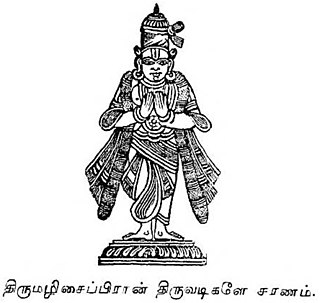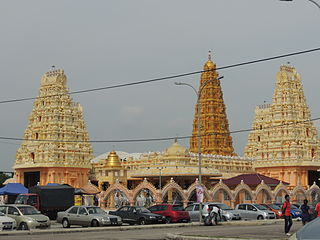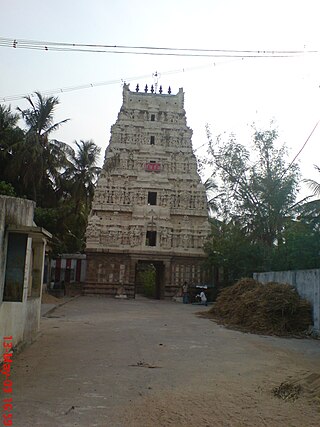Sundararaja Perumal temple may refer to:
Sundararaja Perumal temple may refer to:

Perumal or Tirumal is a Hindu deity. Perumal is worshipped mainly among Tamil Hindus in South India and the Tamil diaspora, who consider Perumal to be a form of Vishnu.

A Divya Desam or Vaishnava Divya Desam is one of the 108 Vishnu and Lakshmi temples that is mentioned in the works of the Alvars, the poet-saints of the Sri Vaishnava tradition.

Tiruchirappalli District is one of the 38 districts, located along the Kaveri River, in Tamil Nadu, India. The headquarters of the district is the city of Tiruchirappalli.
Tiruchengode is a selection-grade municipality located in western part of southern Indian state of Tamil Nadu. It is famous for the ancient hilltop Ardhanareeswarar Temple, dedicated to the unique combined male-female form of Lord Shiva and Goddess Parvathi. This important place of pilgrimage is mentioned in the Tamil work Silapathikaram as 'Nedulkundru' and is celebrated in the hymns of Saivite saints. The equally famous Chenkottu Velavar Temple, dedicated to Lord Murugan, is situated on the same hill. As of 2011, the town had a population of 95,335. As per 2011 population, Tiruchengode is the largest city in Namakkal district. It is also famous for rig business.
Veeravanallur is a selection grade special panchayat town in the Cheranmahadevi taluk of Tirunelveli district in the Indian state of Tamil Nadu.

Tirumalisai Alvar is a Tamil saint revered in the Sri Vaishnavism school of south India, in Tondai Nadu. He was born in 4203 BCE. The legend of this saint devotees of Sri Vaishnavism believe that he was the incarnation of Vishnu's disc, Sudarshana. He is believed to have been born at the Jagannatha Perumal temple, Tirumalisai, by "divine grace".

Vaikhanasa or Vaikhanasagama is a tradition of Hinduism that primarily worships Vishnu as the Supreme God. The tradition draws its name from the philosophy propounded by its founder, Sage Vikhanasa.

Thiru Anbil, or Sundararaja Perumal Temple, in Anbil, a village in the outskirts of Tiruchirappalli in the South Indian state of Tamil Nadu, is dedicated to the Hindu god Vishnu. Constructed in the Dravidian style of architecture, the temple is glorified in the Naalayira Divya Prabandham, the early medieval Tamil canon of the Alvar saints from the 6th–9th centuries CE. It is one of the 108 Divya Desams dedicated to Vishnu, who is worshipped as Sundararajan and his consort Lakshmi as Sundaravalli.

Sri Sundararaja Perumal Temple, better known as Klang Perumal Temple, is a Hindu temple located in Klang, Selangor in Malaysia. Built in 1892, then reconstructed in 2015, it is of the oldest, and the largest Vaishnavite temple in Malaysia, it is often referred to as the "Thirupathi of South East Asia" after its namesake in India. It is the first granite temple in Malaysia.

Nachiyar Kovil or Thirunarayur Nambi Temple is a Hindu temple in Thirunarayur, a village in the outskirts of Kumbakonam in the southern Indian state of Tamil Nadu, is dedicated to the Hindu god Vishnu and his wife Lakshmi. It is the sub urban region of business city of Kumbakonam.
Ulagalantha Perumal Temple may refer to several places:
Jawahar Nagar, named after the first Prime Minister of India, Jawaharlal Nehru, is a developed residential area in North Chennai, a metropolitan city in Tamil Nadu, India.

Anbil is a village in India's Tiruchirappalli district, close to Lalgudi, and situated on the banks of the Kollidam River.

Agaram is a neighbourhood of Perambur and a developed residential area in North Chennai, a metropolitan city in Tamil Nadu, India.
Varadharaja Perumal Temple may refer to:

Alagirinathar Temple is located on the banks of the Thirumanimutharu river at Salem, Tamil nadu, India. The temple is Classified one among the 108 Abhimana Kshethram of Vaishnavate tradition. The other significance of the temple is that it is one of the Pancha Kshethram where Maha Lakshmi was born as Bhargavi- the daughter of Maharishi Bhrigu. The other four temples of the Pancha Kshethram are Sarangapani temple, Kumbakonam, Oppiliappan temple, Nachiyar Koil and Venkateswara Temple, Tirumala. The temple is believed to be of significant antiquity with contributions at different times from Medieval Cholas, Vijayanagara Empire, Chera, Pandyas and Madurai Nayaks. The temple follows Vaikhanasa agama and the temple priests perform the pooja rituals during festivals and on a daily basis. The priests belong to the Vadakalai sect of Vaishnavism, a Brahmin sub-caste. The temple rituals are performed six times a day: Ushathkalam at 7 a.m., Kalasanthi at 8:00 a.m., Uchikalam at 12:00 p.m., Sayarakshai at 6:00 p.m., Irandamkalam at 7:00 p.m. and Ardha Jamam at 10:00 p.m. Each ritual has three steps: alangaram (decoration), neivethanam and deepa aradanai for both Ranganatha Perumal and Ranganayagi. During the last step of worship, nagaswaram and tavil are played, and religious instructions in the Vedas are recited by priests.
Somangalam is a neighbourhood in Kanchipuram, of Tamil Nadu state in India.
Sundararaja Perumal Temple is a Perumal temple situated at Somangalam neighbourhood in Kanchipuram district of Tamil Nadu state in India. This temple is constructed about 950 years ago.